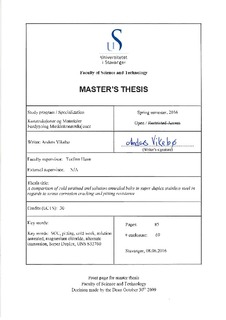| dc.contributor.advisor | Havn, Torfinn | |
| dc.contributor.author | Vikeboe, Anders | |
| dc.date.accessioned | 2016-09-29T07:23:11Z | |
| dc.date.available | 2016-09-29T07:23:11Z | |
| dc.date.issued | 2016-06-08 | |
| dc.identifier.uri | http://hdl.handle.net/11250/2411621 | |
| dc.description | Master's thesis in Mechanical engineering | nb_NO |
| dc.description.abstract | Corrosion place a high cost on the society and selecting the wrong materials in certain environments may have catastrophic consequences. When selecting materials there is also the different manufacturing methods to consider and there might be a difference in corrosion resistance depending on the way the material is manufactured. Also even high grade stainless steels like super duplex may suffer from corrosion in a specific environment.
The scope of the thesis compares the manufacturing methods solution annealing and cold straining on a super duplex stainless steel, and the potential effect on stress corrosion cracking and pitting resistance. Earlier research indicates that there might be some uncertainties regarding this, and the amount of research in this field was lacking compared to studies on austenitic stainless steels.
The objective of this thesis was to develop a test setup using modified versions of the ASTM G36 and G44 standards testing on as received super duplex stainless steel bolts (UNS S32760) of both solution annealed and cold strained quality.
Tensile testing was performed to determine the elongation at yield, and hence being able to determine the percentage of yield for the experiments. The results of the testing were surprising, as the Young’s modulus was around 50 % less than what was expected, due to testing with a threaded bar instead of a smooth. All of the experiments were performed with the bolts stressed to 100 % of offset yield.
For the alternate immersion testing, a test jig was designed and used during the whole experiment which was executed over a time period of 936 hours. This setup used magnesium chloride instead of sodium chloride which was specified in the standard to examine if this would accelerate stress corrosion cracking or pitting corrosion. The results from this experiment showed that the solution annealed bolts seemed to exhibit a higher pitting resistance than the cold strained bolts. Also this experiment indicates that this type of experiment may take too long time to be effective. Four 316L bolts were also tested in the alternate immersion testing and exhibited obvious pitting as expected.
The results however must be considered with caution as only two solution annealed bolts and two cold strained bolts were tested. It is therefore not possible to conclude on this matter. In regards to stress corrosion cracking, no cracks were discovered at 10X magnification, but further metallographic testing should be performed to verify that no cracks are present.
The heated immersion testing in magnesium chloride was performed at 90℃ instead of 155℃ as specified in the standard. An initial test performed for 316 hours produced fracture in the two solution annealed and two cold strained bolts that were tested. No pitting was observed at 10X magnification.
A second heated immersion test was performed for 156 hours and this test may indicate that there is higher stress corrosion cracking resistance in the solution annealed bolts compared to the cold strained. There was however only two bolts of each type tested in this experiment as well, so it is not possible to conclude without further experiments. No pitting was observed with 10X magnification on any of the bolts.
The final results indicate that solution annealed bolts exhibits a higher resistance in regards to both stress corrosion cracking and pitting corrosion. Further testing needs to be performed however to verify this as there a low number of specimens tested. | nb_NO |
| dc.language.iso | eng | nb_NO |
| dc.publisher | University of Stavanger, Norway | nb_NO |
| dc.relation.ispartofseries | Masteroppgave/UIS-TN-IKM/2016; | |
| dc.rights | Navngivelse 3.0 Norge | * |
| dc.rights.uri | http://creativecommons.org/licenses/by/3.0/no/ | * |
| dc.subject | materialteknologi | nb_NO |
| dc.subject | maskinkonstruksjoner | nb_NO |
| dc.subject | konstruksjoner og materialer | nb_NO |
| dc.subject | pitting | nb_NO |
| dc.subject | cold work | nb_NO |
| dc.title | A comparison of cold strained and solution annealed bolts in super duplex stainless steel in regards to stress corrosion cracking and pitting resistance | nb_NO |
| dc.type | Master thesis | nb_NO |
| dc.subject.nsi | VDP::Technology: 500::Mechanical engineering: 570 | nb_NO |

